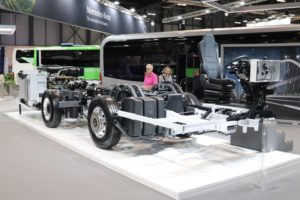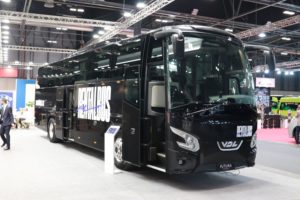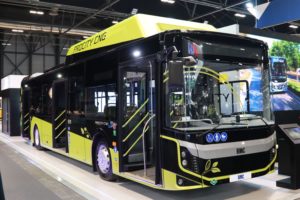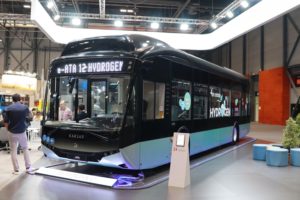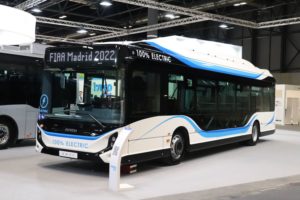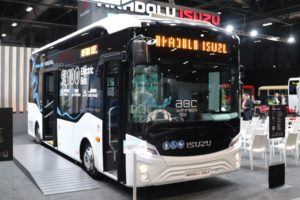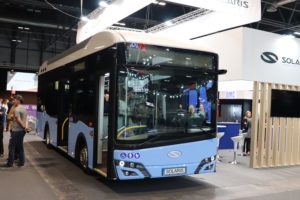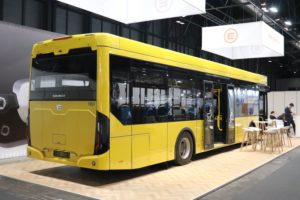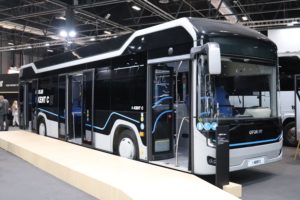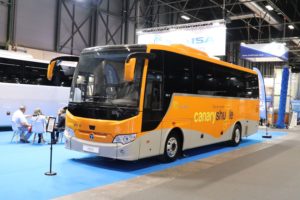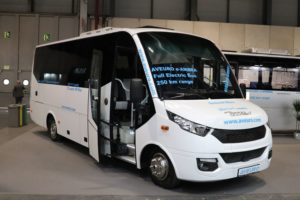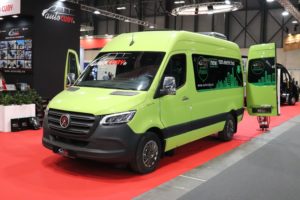FIAA Madrid: a no-show for Spanish vehicles
Stuart Jones has his biennial pilgrimage to Spain to see all the ‘left-hookers’ that may or may not be coming our way. To his surprise, the exhibition featured everyone but the Spanish manufacturers
I have been attending the FIAA Show every other year for decades and always enjoyed the opportunity to touch base with the country’s small coachbuilders as well as the large global players. This year it was very different because, in a coordinated decision, all of the Spanish vehicle manufacturers did not take stands; instead it became a showcase for importers and international producers to display their products. There were local parts, services and ancillaries suppliers present, and in one corner a small number of heritage vehicles were displayed.
EvoBus Iberica
A large presence at the show, Daimler Truck showed three members of the Setra family, a varied Mercedes-Benz integral bus and coach line up and, for the first time, the latest version of the OC500RF chassis, which is built at the Samano plant in Spain where the Setra S215HD Tornado was once built. The OC500RF gains the new electric and electronic architecture announced for the Setra TopClass range at the IAA and has the OM470 engine, Powershift 250-8 transmission and Aquatarder.
As well as the eCitaro with NMC3 batteries there were the 13.09m Intouro M Hybrid, and the 13.115m Tourismo 16RHD/2 with OM470 10.7-litre engine. A new rental scheme for the Tourismo has been launched. Setra models shown were the 14.165m TopClass S517HDH, 13,935m ComfortClass S517HD, both with Active Drive Assist 2 (ADA2) and Active Brake Assist 5. In contrast to the Intouro Hybrid, Setra’s offering is the 13.04m S416LE Business with OM936 260kW/353hp engine. The company will not start to offer electrics in the intercity sector until 2025.
While on the stand I was able to talk to Head of Sales, Roman Biondi, about the state of the European market. He noted that while line and interurban sales continued strongly, even during Covid, the coach market had been ‘crushed like never before.’ Putting it in context he said that in 2009 the market had dropped 30% but was back within two years. In comparison the market was 70% down in 2020 and that in 2022 it was only back to half of its normal size. He was more positive about 2023 saying, ‘We really see signs of recovery in operator’s businesses. Most coach operators in most European countries are back to work with more or less all of their fleets running. Most are quite confident about the future; I think next year there will probably be a big step forward in orders.’ He accepts that with problems in supply chains and difficulties in supplying it will be difficult to organise production, saying, ‘It is a challenge at the moment to cover the high demand.’
On pricing dynamics he said, ‘Once we have a sales contract our price is binding. This is a partnership with our customers. Like everyone we have seen a significant increase in our cost base. Steel and other component costs have risen significantly above inflation, leading to price increases we have not seen for many, many years. It can also mean more than one price rise a year. We have applied a second price rise in 2022 which we have never done before. We have tried to keep the impact as modest for our customers as we can do and have actually remained beneath the current inflation rate.’
Asked whether we might see the OC500 in the UK, Roman Biondi said, ‘We are not planning to import chassis to the UK at this moment. In the coach market we have a fantastic product in the Tourismo. Having started seven years ago with a broader range and gained market share we believe in the advantages of an integral.’ On bus he said, ‘We are now launching the eCitaro in right hand drive and in a real ramp up it is getting the latest stage three technology. We believe there will be a big change in the UK with electromobility.’ He believes the single deck characteristics of the market will shift a bit towards more classical European city bus designs, because of the need to carry the weight of batteries. Because of this, he said, ‘We believe the eCitaro will better fit the UK in future than the diesel Citaro did.’
Across Europe he notes another trend. ‘To what extent it is related to Covid I am not sure, but we see a concentration, particularly of coach operators. A lot of operators with a coach element to their business are stepping out or being bought out. Surprisingly, very few operators have gone bankrupt, probably due to government economic support. I believe, independent of Covid, there would have been and is this process going on.’
VDL & Rentalbus
In its efforts to increase coach deliveries locally, VDL has adopted a different approach in Spain and Portugal to that used elsewhere in Europe, with the emphasis very firmly on rental rather than sale and the establishment of a new operation called Rentalbus, which is said to have 250 coaches available to it. Offering both new and late used vehicles for rental periods of anything between one week and five years, the arrangement includes everything except the fuel and driver with insurance, tyres, repairs, local taxes, inspections, tachographs, geolocalisation and maintenance included. To date over 30 customers have been attracted to the product with over 50 coaches on the books so far and additional new vehicles expected soon to increase the rental fleet.
Two two-axle examples from the Futura FHD2 range appeared on the stand, one in a black livery promoting the Rentalbus concept, but no buses, although there was a heritage example in the old-timer display. VDL has eight dealers in Spain, covering the whole country.
BMC
It is a long time since I have encountered BMC at a major show but they were in Spain with some credible products. New was the 8.5m long NeoCity EV electric bus which is a development of the NeoCity diesel model. The electric engine is a TM4 SUMO MD3000 permanent magnet synchronous design delivering 3000Nm and 145kW continuous power while the batteries are six 33kWh Akasol Li-Ion NMC 655V units giving a total capacity of 198kWh.
The second bus was an integral two-door Procity CNG in yellow with a huge box on the roof containing the gas cylinders which have a capacity of 1,584 litres. The engine is a Cummins L9N E6 six-cylinder CNG unit delivering 235kW at 2,000rpm. ZF supply the axles and the automatic transmission.
Karsan
Karsan had a major presence with what I think were the same vehicles that it had recently shown at the IAA event in Hanover at which the new e_ATA12 Hydrogen was unveiled. It’s presence at Madrid (and all other major recent shows) reflects the ambition to become a globally recognised mobility brand. On show were the Jest minibus, the e-ATAK midi in both electric and fully autonomous forms, 10m and 18m articulated versions of the e-ATA and, taking pride of place, the eATA 12 Hydrogen, with twin 125kW electric hub motors, a 70kW fuel cell, and five roof-mounted storage tanks totalling 1,560 litres, giving a 500km range. A 30kW LTO battery provides an additional power source. Karsan recognises that hydrogen is currently only 2% of the market but believes that this will grow.
It has appointed e-busKar SL to represent it in Spain, and taken a stake in the company. To date 20 vehicles have been sold to Spanish customers, among them National Express subsidiary, ALSA.
Iveco Bus
On a large stand, Iveco Bus showed a wide variety of buses all offering ecological credentials. Both 12m and 9.5m (2.35m wide) versions of the electric E-Way were shown with Iveco branding, though in France these models carry the Heuliez brand. E-Way customers in Spain include Sevilla (5x12m), Barcelona (11×10.7m) and Gerona (2x12m). The E-Way has been upgraded with 485kWh Forsee batteries in place of the previous 460kWh Zen35 units giving a 5% increase in either range or passenger capacity.
Completely new was the 12m hybrid diesel low entry Crossway, a mild hybrid design with Voith DIWA transmission. The same model is also offered with CNG or electric drive. Crossway is built at the Vysoke Myto plant in the Czech Republic, where 15% of production is currently CNG, driven by demand from Italy and particularly France. The Natural Gas Streetway is a model Iveco Bus is trying in a number of markets including Germany and Spain as well as Kazakhstan and Azerbaijan but will not be offering it in France and the Benelux countries. Only previously offered as a diesel or a serial hybrid previously, the 12m Urbanway was shown as a CNG model for the first time. It will be offered with the Cursor 09 CNG engine at 12 and 13m on two axles and as a diesel at 10.8m, 12m, 13m as well as a 14.5m tri-axle. The Natural Gas Daily shown had an Indcar converted low centre entrance. Iveco Bus is the leader in the Spanish minibus market with 32.4% in 2021 and a 32.7% share up to September this year. On display outside the exhibition there were Daily minibuses with Unvi and Indcar conversions as well as a Ferqui bodied EuroMidi.
Iveco reported that overall, in all segments, sales dropped from a pre-Covid level of 41,000 units to under 30,000 units with the current projection for 2022 being 34,000 units. The sector suffering the most is the touristic market, which in France dropped 70% in 2020 and a further 30% in 2021, but has risen 85% on last year’s level so far in 2022. It is expected to increase further in 2023 but not return to pre-Covid levels until 2024. We were told that the French intercity market is 80% diesel and 20% CNG, with the Crossway model taking around 90% of the CNG element because it is a mature and affordable product that offers a good solution when fuelled with biomethane.
Another development, announced in July, has seen the group partner with Hyundai in its HTWO subsidiary on fuel cell development. The first project being worked on is a bus.
Caetano Bus
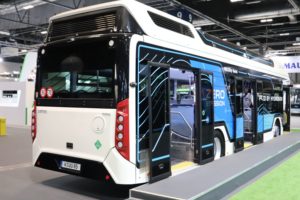
Representing Caetano’s hydrogen products was their German demonstration bus. It has Caetano’s own H2 City Gold three-door body and Toyota fuel cell technology
Showing its alternative propulsion capabilities with two city buses was Caetano Bus. One was a German registered demonstration bus with Toyota fuel cell technology which featured Caetano’s own H2 City Gold three-door body. Also on the stand was a 100% electric Caetano eCC-1121L chassis with Unvi C21 body (the only Spanish bodied bus I noticed) that has been on demonstration duties with EMT Madrid carrying their colours. Caetano Bus has partnerships with Unvi in Spain and Caio in Brazil as well as offering it own bodies from the Vila Nova de Gaia plant on its chassis.
Caetano’s bus chassis are built in Portugal at the Ovar plant, once home to the Toyota Optimo. To date, close to 80 have been sold since their launch in 2020, with more than 50 going to Germany, while Abellio in the UK has also purchased batches.
Anadolu Isuzu
Four exhibits were present on the Anadolu Isuzu stand, among them a Grand Toro model to Class 2 specification rather than the Class 3 coach we had seen in the Minibus Euro Test prior to the show. Also of possible interest to UK buyers is the NovoCiti Volt. Offered with either 22kWh or 268kWh of battery capacity and the TM4 Sumo M electric motor giving maximum power of 270kW and continuous power of 189kW, the diminutive NovoCiti Volt is a smally city bus measuring up to 8010mm. Range varies between 300km and 350km depending on batteries and the bus carries 25 seated and 26 standing passengers in standard form.
Also shown were the Turquoise a 7.72m long coach with up to 33 seats, a four cylinder Isuzu engine and a choice of manual or automatic transmission and the Kendo 13 CNG, a 13m CNG fuelled coach with Cummins L9NE6E320 320hp gas engine, ZF Ecolife transmission and up to 63 seats.. A 12.3m diesel is also offered with 365hp engine and ZF 6AP1700B transmission.
Solaris
Solaris has enjoyed considerable success in Spain and will deliver over 700 in the 2021-2023 period, including 159 in 2021. Of these, 150 are electric with 48 of these already on the road. EMT Madrid has placed a huge 250 bus order for the Urbino 12 CNG.
Solaris now has a stronger local bond with its acquisition by the Spanish train manufacturer, CAF. Having just expanded its manufacturing facilities at Bolechowo in Poland, with a new 10,000sqm warehouse and a new charging park, the company’s only exhibit in Madrid was a 9.2m Urbino 9LE electric, a model launched last year with a capacity of 73 passengers, 21 of them seated. It is 2.5m wide and can be either a class 1 city bus or a class 2 intercity bus with a 220kW central traction motor and Solaris battery packs delivering up to 350kWh.
It recently launched a hydrogen version of the Urbino 18 articulated city bus with a 100kW fuel cell, 240kW central motor, and tanks holding 51.2kg of hydrogen to give a range of 350km. Refuelling takes between 10 and 20 minutes.
Ebusco
The Dutch Ebusco concern designs and engineers its electric city bus products in Holland and has them built in China by FTBCI, a joint Australian-Chinese venture. On show was an example of the more conventional of its two product ranges, the Ebusco 2.2, featuring a steel body from a batch for BVG in Berlin. Not displayed was the Ebusco 3.0 which has a stainless steel frame clad with composite body structure that tips the scales at 9.5 tonnes complete with batteries. On the 3.0 the 17cm deep Gotion batteries are mounted beneath the floor while on the 2.2 the CATL LFP batteries are located on the roof. The specification features recognisable European components including ZF AV130 hub motors (2x125kW), ZF independent front suspension, Ventura doors, Thermo King air conditioning, Kiel or Ster seating, Wabco air systems and Knorr brakes.
Having just launched the first right hand drive 2.2 model in Melbourne, Australia, Ebusco is looking to the UK market.
Otokar
As at Innotrans, Otokar (represented in Spain by Somauto) showed the eKent-C 12m electric city bus. Capable of carrying up to 108 passengers, it has a Voith 410kW central electric motor and battery capacity of up to 350kW. Also present were the Centro-C microbus with 110kWh batteries and the Territo U, Ulyso TH and Navigo-T coaches. The Territo U is 12.2m with 53 seats, DAF MX11 engine developing 370hp/270kW @1600rpm, ZF 6AP automatic gearbox and a 4.8cum luggage capacity. In the colours of an operator named Rovira which was celebrating its centenary was a Ulyso TH. A 10.10m coach on 19.5inch wheels, it seats up to 39 and matches the Cummins ISB6.7E6 320hp engine with the ZF Ecolife automatic transmission. New, and also seating up to 39 was the Navigo T 9.17m coach with Cummins ISB4.5E6 engine and Allison automatic transmission.
Temsa
Temsa has a new Spanish dealer which is already an established Cummins dealer. My understanding is that they will be concentrating on the midi sector and at relatively low specification levels because that is where they see the market at present. On the stand was a 7.7m MD7 Plus coach with 33 seats or 31 plus courier, powered by a 4.5-litre FPT engine. A second, rather larger midi was an MD9 in bright orange Canary Shuttle livery. Full sized coaches were represented by an HD13 coach. This vehicle can be either 12 or 13m long, the stand exhibit being a longer one with 63 seats and a DAF MX11 engine.
Minibuses
Aveuro
No less than four vehicles appeared on the stand of this young Romanian coachbuilder and converter, among them the 19-seat conversion of a Sprinter 517 that had participated in the Minibus Euro Test on the days preceding the exhibition. The other three were all coachbuilt on Daily chassis. One was a 31-seat VIP coach while the other two were examples of the Aveuro e-AMBRA, a Daily with electric driveline and a 250km range. Of these, one was a 35+1+1 school bus and the other a city bus version with a low rear platform for wheelchair passengers.
AutoCuby
Producers of some very attractive conversions, AutoCuby’s large stand featured an array of mainly black painted conversions of Mercedes-Benz Sprinter and Iveco Daily chassis. The exception was a 100% electric Sprinter in a green livery.
Steinborn
Two Sprinter conversions were shown to different specification levels, the more basic of the two being advertised at €66,000.
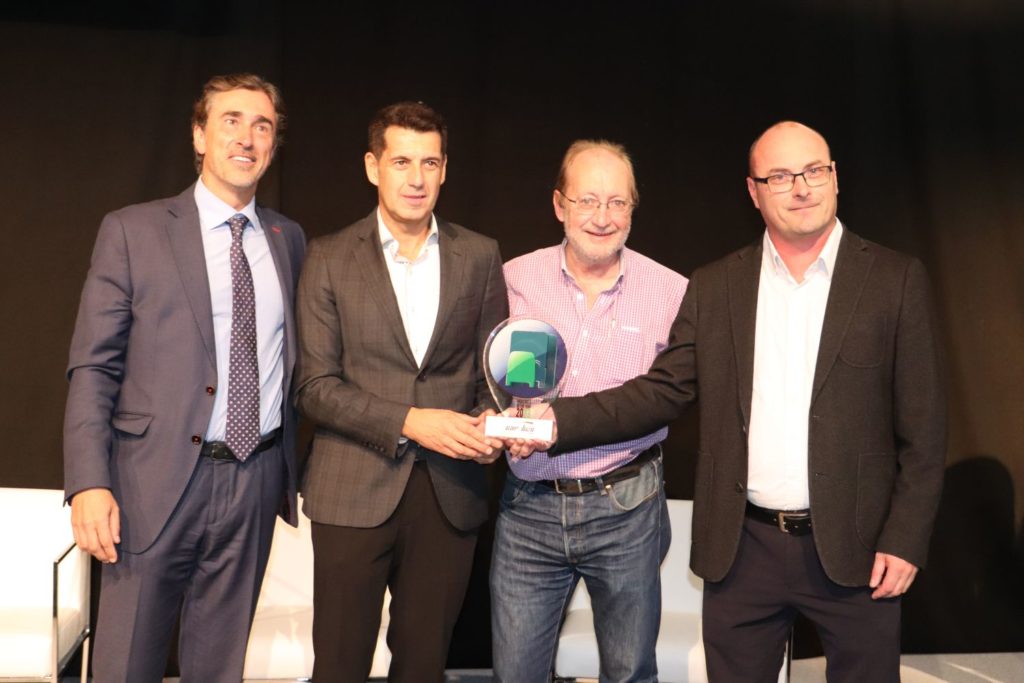
Winner of the International Bus & Coach of the Year’s Minibus of the Year 2023 accolade was the Car-Bus.net Shaula coachbuilt minibus on an uprated Sprinter chassis. The trophy was presented to Car-Bus Commercial Director, Jordi Monferrer Munoz, by Jury President, Tom Terjesen accompanied by Miguel Saez and David Moneo, Director of IFEMA Movilidad
